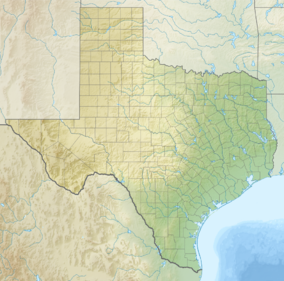Muleshoe National Wildlife Refuge: Difference between revisions
geobox to infobox conversion |
|||
| Line 18: | Line 18: | ||
| coords = {{coord|33|57|14|N|102|45|44|W|format=dms|display=inline,title}} |
| coords = {{coord|33|57|14|N|102|45|44|W|format=dms|display=inline,title}} |
||
| coords_ref = |
| coords_ref = |
||
| area_acre = 5000 |
|||
| area = {{convert|5,000|acre|ha|0}} |
|||
| established = 1935 |
| established = 1935 |
||
| visitation_num = |
| visitation_num = |
||
Revision as of 05:23, 24 December 2016
| Muleshoe National Wildlife Refuge | |
|---|---|
 Sandhill cranes at Muleshoe NWR photo by Wyman Meinzer | |
| Location | Bailey County, Texas |
| Nearest city | Muleshoe, Texas |
| Coordinates | 33°57′14″N 102°45′44″W / 33.95389°N 102.76222°W |
| Area | 5,000 acres (20 km2) |
| Established | 1935 |
| Governing body | U.S. Fish and Wildlife Service |
| www | |

Muleshoe National Wildlife Refuge is the oldest National Wildlife Refuge in the U.S. state of Texas, having been established in 1935. It is located about twenty miles (32 km) south of Muleshoe, the seat of Bailey County. It is some fifteen miles (24 km) north of Morton on Texas State Highway 214.
The refuge includes several intermittent salt lakes, some of which have been modified to extend their wet periods. Paul's Lake, on the east side of Highway 214, is spring fed, and hosts wildlife during times when the other lakes are dry.
The 5,000-acre (20 km2) refuge is a stop for migratory waterfowl flying between Canada and Mexico. If sufficient water is present, during the winter it hosts tens of thousands of sandhill cranes. The largest number of cranes ever recorded was 250,000, during February, 1981.
The cranes are most visible at dawn and at dusk, as they leave the lakes during the day to feed in nearby fields.
Other wildlife includes wood warblers, meadowlarks, raptors, burrowing owls, blacktailed prairie dogs, jackrabbits, cottontail rabbits, coyotes, and badgers.
The prairie ecosystem includes plant life such as wildflowers, grasses, yucca, cacti, and mesquite. Rangeland management techniques include controlled burning and grazing.
Northeast of White Lake is a small area of white gypsum dunes, similar to those found at White Sands National Monument in New Mexico, though these are much less expansive.
-
Entrance to Muleshoe National Wildlife Refuge
-
Sandhill cranes in flight, Muleshoe National Wildlife Refuge
-
Upper Goose Lake, Muleshoe National Wildlife Refuge
See also
- Grulla National Wildlife Refuge
- Buffalo Lake National Wildlife Refuge
- Blackwater Draw
- Llano Estacado
External links
- Muleshoe National Wildlife Refuge Official Site
- Handbook of Texas Online: Muleshoe National Wildlife Refuge
- Photos of the Llano Estacado





